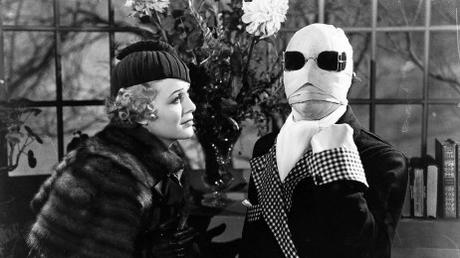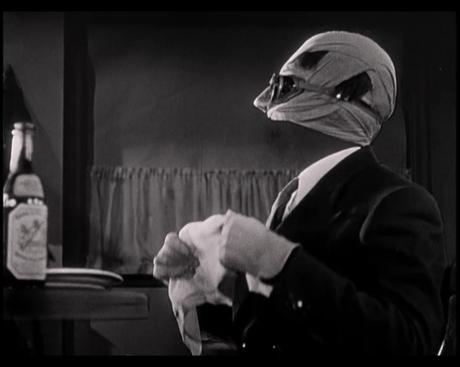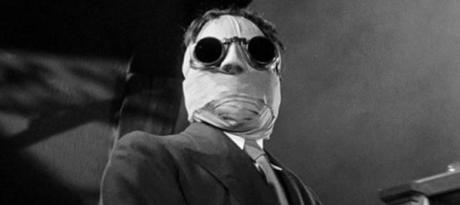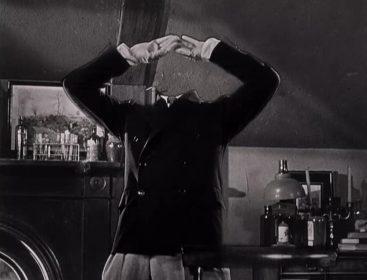 In 1931, director James Whale unleashed Frankenstein upon the moviegoing public. The groundbreaking horror film went on to be the biggest hit of the year. Naturally the Laemle family who ran Universal Studios wanted a sequel, something Whale was not keen on yet. The filmmaker decided the best way to avoid doing this was the time-tested strategy of stalling. Instead of returning to Frankenstein's lab, he decided to tackle another literary mad scientist, this one from the pages of an HG Wells novel. This 1933 film also broke new cinematic ground and proved that horror was here to stay. The legendary Universal Monsters stable grew by one member with this movie, and that member was the Invisible Man.
In 1931, director James Whale unleashed Frankenstein upon the moviegoing public. The groundbreaking horror film went on to be the biggest hit of the year. Naturally the Laemle family who ran Universal Studios wanted a sequel, something Whale was not keen on yet. The filmmaker decided the best way to avoid doing this was the time-tested strategy of stalling. Instead of returning to Frankenstein's lab, he decided to tackle another literary mad scientist, this one from the pages of an HG Wells novel. This 1933 film also broke new cinematic ground and proved that horror was here to stay. The legendary Universal Monsters stable grew by one member with this movie, and that member was the Invisible Man.
On a snowy night, a stranger wrapped in bandages takes up lodging at a local inn, in a small English village. When the paranoid townspeople see fit to run him off, the stranger removes his bandages and suit to reveal that he is completely invisible. In a manic fit, he evades those around him and escapes into the night, we as viewers have just met Dr. Jack Griffin the Invisible Man. Elsewhere his fiance Flora is unaware of what happened to him and urges her father Dr. Cranley (played by Henry Travers of It's a Wonderful Life fame) to find him.His colleagues soon learn of his experiments which could turn his skin

The first thing which draw people's attention in the Invisible Man is the special fx which are years ahead of their time. Working with visual fx pioneer John P. Fulton, Whale had to come up with ways to shoot someone and have them not show up onscreen. For scenes where the Invisible Man was interacting unseen with items, they utilized a complex system of wires to move objects as needed. They also employed a rather clever effect to have his footprints materialize in the snow as he walked. But when Dr. Griffin was clothed, that was when a challenge arose. Fulton and Whale had to wrap actor Claude Rains' exposed flesh in black velvet. They used early super-imposing techniques to have what they film laid over said black velvet once he was onscreen. To this day I defy you not to be amazed as the Invisible Man unravels his bandages before an audience of shocked onlookers.
As per James Whales' style his influence from the German Expressionist movement is clearly evident in the Invisible Man. His frequent collaborator in cinematography the great Arthur Edeson was completely saw eye-to-eye with the famed filmmaker in this regard and helped craft the visual style of the. Though the look of the film had a gothic moodiness to it, the director's trademark sardonic humor is ever-present. Considering the Invisible Man largely revolves around a powerful megalomaniac confined with his madness to a tiny village, that humor pays off in spades. Dr. Griffin travels around knocking over baby carriages (with the baby still inside mind you) and stealing hats with a manic glee. Helping bring this side of the movie out are frequent Whales collaborators

Considering the lead of this film is largely unseen the actor who embodied him would need to find ways to work in an unconventional method. That lead actor was none other than Claude Raines, before he became one of the greatest character actors in Hollywood history he was terrorizing the human race. Despite the studio's attempt to cast actors like; Boris Karloff or Paul Lukas in the lead, Raines was Whales' first and only choice. Thanks to inhaling toxic gasses in the trenches of World War I, the British thespian had a distinctly raspy voice which was a necessity for a character who was largely heard but not seen. It is hard to watch this film and not think he was having a ton of fun cutting loose with completely manic energy in his performance. Joining him in the cast was Gloria Stewart who was nothing short of a true Renaissance woman. She had previously worked with James Whale in the gothic fan favorite the Old Dark House and he brought her back for this picture. She worked consistently in films through the 30's, but from there transitioned into stage work as well

Like the other Universal Monsters, the Invisible Man was a hit which spawned a number of sequels. 1940 saw Vincent Price play a new Invisible Man and that same year we also had an Invisible Woman. Once World War II hit, we even had the espionage-laden Invisible Agent. Fun as they may be they lacked the flair of the of the original Invisible Man. Recently an Invisible Man reboot is doing a great deal of success at the box office courtesy of Jason Blum and Leigh Whannell. The film introduced the world to another iconic Universal Monster and broke new ground in special fx.

